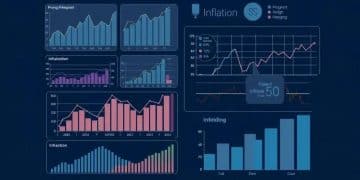Rising interest rates affect investment strategies: what to know

Rising interest rates affect investment strategies by increasing borrowing costs, prompting investors to adjust their portfolios through diversification, risk management, and a balance between long-term and short-term investments.
Rising interest rates affect investment strategies in profound ways. As rates climb, investors face both challenges and opportunities that could reshape their financial journeys. Have you considered how this trend impacts your investments?
Understanding the impact of interest rates on investments
Understanding how interest rates impact investments is crucial for any investor. When rates change, the landscape of investment opportunities shifts significantly. This affects stock prices, bond yields, and real estate markets.
Higher interest rates can lead to increased borrowing costs. Companies may cut back on expansion plans, influencing their stock values. Similarly, when rates rise, bond prices tend to fall. Investors need to adjust their strategies accordingly.
How Interest Rates Influence Market Behavior
The effect of rising rates is felt throughout the economy. Investors often move their money in response to changing conditions, leading to fluctuations in various asset classes.
- Stock market trends: Higher rates can prompt declines in stock prices.
- Real estate effects: When borrowing costs increase, housing demand may decrease.
- Bond market: Investors might shun existing bonds for new issues offering higher yields.
The relationship between interest rates and the economy is complex. A sustained increase could lead to slower economic growth. As borrowing becomes costlier, businesses and consumers alike may tighten their belts. This can further impact investment strategies as expectations shift.
Adjusting Investment Strategies
Investors should monitor interest rate trends closely. When rates rise, reallocating assets can help mitigate risks. Consider adjusting portfolios to include sectors that typically perform well during such periods.
Additionally, diversifying investments can provide better stability. Some investors may even look toward emerging markets, which might offer different opportunities despite rising rates at home. Being proactive can make a significant difference in how investments perform through economic changes.
In summary, remaining informed about interest rates and their impact on investments is essential. Adapting to these changes can help position investors for continued success.
Adapting your portfolio in a changing market

Adapting your portfolio in a changing market is essential for successful investing. When interest rates rise, it’s important to reassess your financial strategy. The market conditions can shift rapidly, and being prepared is key.
As interest rates increase, certain sectors tend to perform better than others. For example, financial stocks often benefit from rising rates because they can charge more for loans. On the other hand, utilities and real estate investment trusts (REITs) may struggle as their borrowing costs rise.
Strategies for Portfolio Adjustment
To stay ahead in a shifting market, consider the following strategies for adjusting your portfolio:
- Diversification: Spread your investments across different asset classes. This reduces risk and maximizes potential returns.
- Sector rotation: Shift your focus to sectors that thrive in higher interest rate environments. Look for opportunities in finance and technology.
- Bonds reassessment: Evaluate the duration of your bonds. Shorter-term bonds can become more attractive as they are less sensitive to rising rates.
Paying attention to market indicators can also help you adjust faster. Monitor rate announcements and economic data closely. These factors often set the tone for market sentiment.
Maintaining Flexibility
Flexibility is crucial in a changing market. Being willing to make adjustments quickly can save you from potential losses. Consider using stop-loss orders to protect your investments.
In addition, regularly reviewing your portfolio helps ensure it aligns with your financial goals and risk tolerance. Make it a habit to check in on your investments, particularly during economic changes.
By embracing an adaptable mindset, you can better navigate the ups and downs of the market. Remember that informed decisions lead to effective management of your portfolio during these dynamic times.
Risk management strategies during interest rate hikes
Managing risk during interest rate hikes is crucial for any investor. As interest rates rise, the potential for losses in various asset classes increases. Being proactive in risk management can help safeguard investments and ensure financial stability.
One effective way to manage risk is through diversification. By spreading your investments across different sectors and asset classes, you can reduce the impact of rising rates on your overall portfolio. This way, if one area suffers, others may remain stable or even thrive.
Key Risk Management Strategies
To navigate the challenges posed by rising interest rates, consider the following strategies:
- Use of hedging: Employing options or futures can protect against price declines in your investments.
- Rebalance your portfolio: Regularly assessing your asset allocation ensures it aligns with your risk tolerance and market conditions.
- Invest in shorter-duration bonds: These bonds tend to be less sensitive to interest rate increases, helping to mitigate risks.
Staying informed about market trends is also vital. Watching economic indicators can provide insights into how future interest rate changes might affect your investments. Understanding the broader economic environment can help in making timely adjustments to your portfolio.
Creating a Flexible Investment Plan
A flexible investment plan allows you to react to market changes. This means being open to shifting your strategy as conditions evolve. For instance, you might choose to increase your cash reserves during periods of uncertainty to take advantage of future opportunities.
Moreover, ensuring that your investments align with your long-term financial goals is essential. Constantly reviewing your strategy not only keeps you aligned with your objectives but also enables you to manage risks effectively as market conditions change.
Long-term vs. short-term investment considerations

When deciding between long-term and short-term investments, several factors come into play. Understanding the differences can help you choose the best path for your financial goals. While both strategies have their benefits, they also come with unique risks and rewards.
Long-term investments typically involve holding assets for several years or even decades. This approach can lead to significant growth due to the power of compounding. Investors can take advantage of market fluctuations, giving their investments time to recover from downturns.
Benefits of Long-term Investments
Here are some key benefits to consider:
- Compounding returns: Earnings on investments can generate even more earnings over time.
- Lower transaction costs: Fewer trades mean you save on fees and commissions.
- Tax advantages: Long-term capital gains often have lower tax rates than short-term gains.
On the other hand, short-term investments usually involve assets held for a shorter period, typically less than a year. This strategy can be appealing for those looking to take advantage of market trends quickly.
Benefits of Short-term Investments
Short-term investments come with their own set of advantages:
- Quick returns: Short-term trades can capitalize on immediate market movements.
- Liquidity: Easier access to cash, as these investments mature quickly.
- Flexibility: More opportunities to adjust strategies based on current market conditions.
When choosing between these two strategies, consider your financial goals, risk tolerance, and investment timeline. Long-term investments are generally better for those who can wait for growth and have a higher risk tolerance. Conversely, short-term investments may suit those needing quicker access to funds or are willing to accept greater risks in pursuit of immediate returns.
FAQ – Frequently Asked Questions about Interest Rates and Investment Strategies
What are the main effects of rising interest rates on investments?
Rising interest rates can lead to higher borrowing costs, affecting stock prices and bond yields. They can also impact real estate markets.
How can I adapt my investment portfolio during interest rate hikes?
Consider diversifying your investments, reallocating into sectors that thrive during rate hikes, or investing in shorter-duration bonds.
What risk management strategies should I use during interest rate increases?
Utilize diversification, hedging strategies, and regular portfolio rebalancing to help manage risks associated with rising interest rates.
Should I focus on long-term or short-term investments in a changing market?
It depends on your financial goals. Long-term investments can yield compounding rewards, while short-term investments can provide quicker returns.





